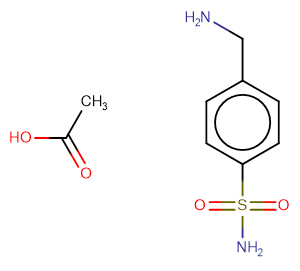
Mafenide Acetate
CAS No. 13009-99-9
Mafenide Acetate( —— )
Catalog No. M21177 CAS No. 13009-99-9
Mafenide Acetate is a sulfonamide-type medication??inhibits the enzyme carbonic anhydrase and is used as topical anti-infective especially in burn therapy.
Purity : >98% (HPLC)
 COA
COA
 Datasheet
Datasheet
 HNMR
HNMR
 HPLC
HPLC
 MSDS
MSDS
 Handing Instructions
Handing Instructions
| Size | Price / USD | Stock | Quantity |
| 50MG | 43 | Get Quote |


|
| 100MG | 61 | Get Quote |


|
| 200MG | 82 | Get Quote |


|
| 500MG | 117 | Get Quote |


|
| 1G | 161 | Get Quote |


|
Biological Information
-
Product NameMafenide Acetate
-
NoteResearch use only, not for human use.
-
Brief DescriptionMafenide Acetate is a sulfonamide-type medication??inhibits the enzyme carbonic anhydrase and is used as topical anti-infective especially in burn therapy.
-
DescriptionMafenide Acetate is a sulfonamide-type medication??inhibits the enzyme carbonic anhydrase and is used as topical anti-infective especially in burn therapy.
-
In Vitro——
-
In Vivo——
-
Synonyms——
-
PathwayOthers
-
TargetOther Targets
-
Recptorothers
-
Research Area——
-
IndicationBurnsSkin Burn Requiring Skin Graft
Chemical Information
-
CAS Number13009-99-9
-
Formula Weight246.29
-
Molecular FormulaC9H14N2O4S
-
Purity>98% (HPLC)
-
SolubilityDMSO:35 mg/mL (142.11 mM)
-
SMILESCC(=O)O.NCc1ccc(S(N)(=O)=O)cc1
-
Chemical Name——
Shipping & Storage Information
-
Storage(-20℃)
-
ShippingWith Ice Pack
-
Stability≥ 2 years
Reference
1. Haynes B.W. Jr. Mafenide acetate in burn treatment. N Engl J Med 1971. 284(23): p. 1324.
molnova catalog



related products
-
N-BENZYLFORMAMIDE
N-BENZYLFORMAMIDE is a natural product from Lepidium meyenii Walp.
-
Aspalathin
Aspalathin is a C-linked dihydrochalcone glucoside found in rooibos tea, a herbal tea prepared from the South African rooibos plant, Aspalathus linearis (Fabaceae).
-
CFI-402257
CFI-402257 is a orally active, and potent highly selective small-molecule inhibitor of Mps1 with Ki of 0.09 ± 0.02 nM.



 Cart
Cart
 sales@molnova.com
sales@molnova.com


